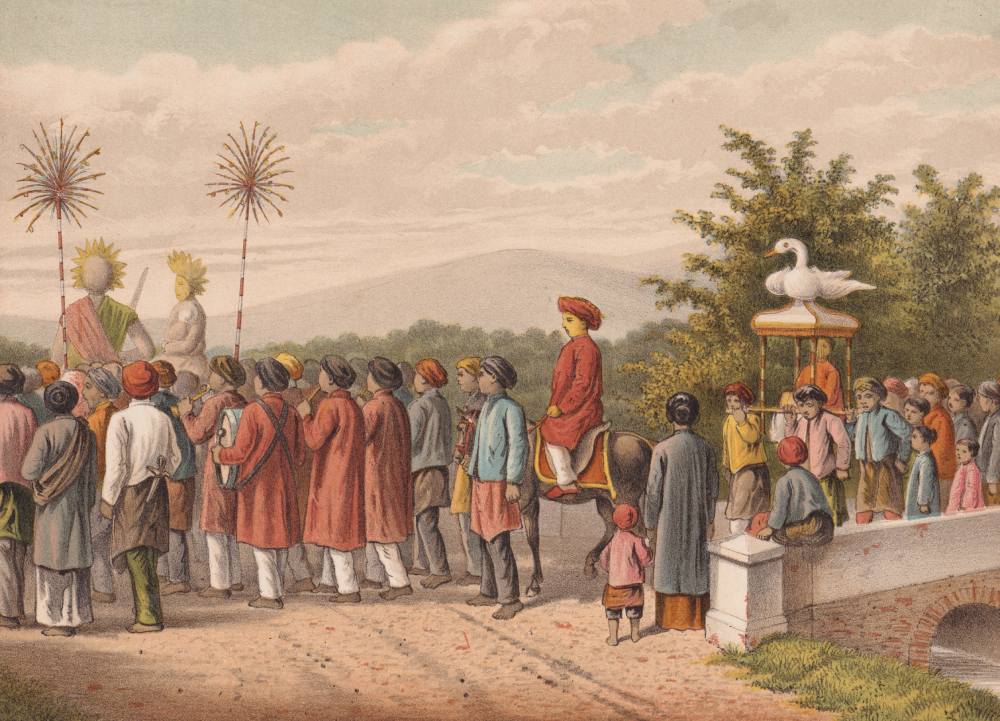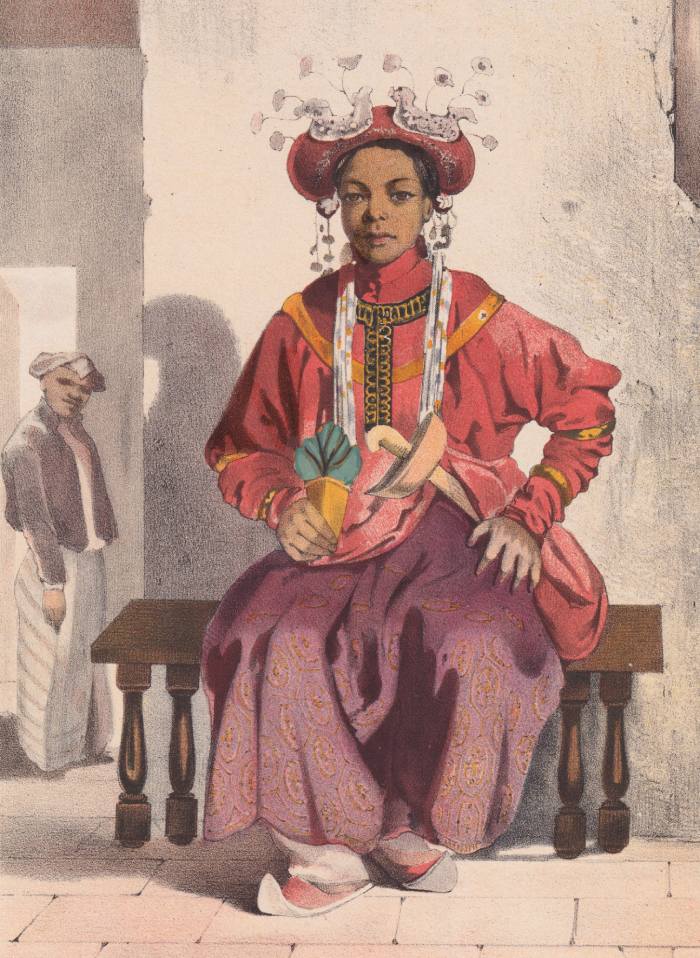
In a rapidly modernising Indonesia, many old traditions and attire have gradually faded from daily life. However, wedding celebrations still show a vital link to the past, where old customs, some centuries old, remain a testament to Indonesia’s rich heritage, showcasing the diverse influences that have shaped the nation’s identity. In this article, Sake Santema from Indies Gallery, will share a small window in time, showcasing a collection of his antique prints and photographs depicting mid to late 19th century wedding scenes.
Shown in the 1883 lithograph above is a Muslim wedding procession in Java. The groom rides a horse while the bride is carried on a palanquin with a swan motif on top. At the front of the procession is the presence of Ondel-ondel, which refers to the Betawi Java folk performance and the puppets that provide protection against evil spirits.
Ondel-ondel is one of a few Indonesian folk performances that has survived and is still being regularly performed but shifted mostly from a protective performance against evil spirits into street entertainment. Indonesian Muslim weddings are often filled with intricate ornaments, vibrant colours, and grand processions. Many of these are believed to be influenced by ancient traditions and civilisations dating back to the Hindu-Buddhist era, which flourished up until the 1500’s in Maritime Southeast Asia. Particularly in the ancient Majapahit kingdoms of Java and later Bali, many of today’s wedding traditions are believed to be influenced by those times.
The Indonesian archipelago spreads from Sabang north of Western Sumatra to Merauke in Southern Papua, a distance of 5200 kilometres. With a diversity of over 1300 recognised ethnic groups and a staggering 700 unique languages, the country is home to a myriad of wedding traditions. Below are three intriguing and perhaps lesser-known wedding customs.
In the matrilineal (through the mother line) Minangkabau culture of Sumatra, the bride and her family make the marriage proposal and are involved in most of the wedding plans; the father of the bride holds little authority in these matters. Any children born from the union inherit the clan or surname of the bride.
Among the Tidung people of Borneo, a ritual prohibits newly wedded couples from using the toilet for 72 hours immediately after their wedding ceremony; doing this is believed to bring forth a multitude of blessings to the marriage. Family members are put in place who ensure that they are fed with small quantities of food and liquid while offering moral support to help them successfully navigate through this period of abstinence.
In Lombok, the Sasak people have a tradition called the Merariq, also referred to as the “Kidnapping of the Bride”. The bride-to-be must be secretly abducted from her house at night to avoid any commotion. Should there be a commotion, the groom would be fined. The couple are no strangers to each other, as it is common that the couple has been dating for quite some time. But once the “kidnapping” has taken place, there often is no turning back.


These studio portraits capture a bride and groom in a photo studio in Batavia around the year 1870, elegantly dressed in traditional attire. Both are adorned with clusters of jasmine flowers as a symbol for purity, sincerity, and loyalty. Jasmine flowers in wedding attire are also found in Indian and Arabic culture. It is not certain if these two young people were a couple, or that they were just posing for the photograph.
Early studio photographs and published prints often lack accuracy for various reasons. One of these reasons is that photographers aimed to capture multiple details within a single composition, leading to a hybrid of styles. And in early prints depicting Indonesian scenes, European print makers would improvise by combining gathered information, resulting in a blend of various details within a single print.
But most of all, fashion in the port cities of Asia, including the prominent city of Batavia, has been shaped by the influence of trade. The exchange of Chinese and European textiles, as well as those originating from various regions within islands in Southeast Asia, was facilitated through these bustling trade routes. Clothing and textiles of diverse origins were worn together, and produced a range of cultural reactions. While local production contributed to the fashion scene, the availability of imported varieties further enriched the sartorial landscape of these port cities.

This lithograph from the year 1852 shows a Sundanese groom dressed in his wedding attire, complete with a traditional dagger known as a kris. In the background, the groom’s father keeps a close eye on his soon-to-be-married son. The kris holds significant importance in Javanese wedding customs, as it is an integral part of the groom’s ensemble. It is customary for the kris to be adorned with delicate chains of jasmine flower arrangements. These floral adornments symbolise the groom’s desire to demonstrate thoughtfulness and patience in his marriage.
In his hands, he delicately holds a few betel leaves. Across Malay, Straits Chinese, and Hindu cultures, the betel leaves and nuts symbolise courtship and play a prominent role in betrothal rituals. Even in present-day Malay weddings, the betel leaf continues to be featured in various forms. For instance, the Sirih lat-lat, a small floral arrangement adorned with betel leaves, is traditionally presented to the groom on the wedding day. This gesture signifies the bride’s preparedness to receive the groom and his entourage, marking an important moment in the wedding celebration.

This studio portrait, taken circa 1860, shows a Chinese bride from Batavia (Jakarta) in wedding attire. During the late 19th century, while some Chinese immigrants and their descendants embraced Dutch customs and lifestyles, others retained a strong connection to their Chinese roots. However, in this photograph, we witness a fusion of styles, indicating the blending of different influences over time. The headdress and footwear exhibit distinct Chinese characteristics. She wears a Chinese style skirt with a Baju Kurung, a garment worn in the islands of Southeast Asia, Sri Lanka, and Goa. Notably, the bride’s jewellery showcases a vibrant combination of Chinese and indigenous designs.
Whether it is a traditional Javanese, Sasak or Minangkabau wedding, or a fusion of cultures, the essence of Indonesian weddings lies in the celebration of love, unity, and the coming together of families.
The antique photographs and prints shown in this article are offered for purchase by Indies Gallery, a dealer in authentic maps, prints, books, and photographs, dating from the fifteenth to the twentieth century. Read the full descriptions on indiesgallery.com Indies Gallery also offers these decorative artworks as reprints. You will find these at oldeastindies.com





